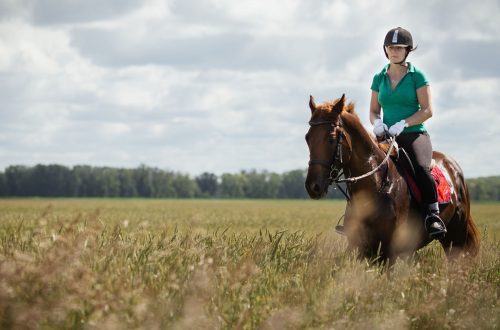
Lady’s seat. Great and terrible.
Any mention of the ladies’ saddle on the vast Russian-language Internet invariably leads to the same discussions. Among the comments on any article, photo or video, you can find such as “uncomfortable”, “crooked”, “sideways”, “my horse’s back “left the chat”, “scoliosis”, “dangerous”, “impossible to ride”, “ instrument of torture” and so on, reflecting the negative attitude of the audience towards the side saddle.
But is this really the case? Let’s figure it out.
The situation with women’s riding in Russia at the moment is developing in such a way that there are very few practicing riders. Those who have tried to ride in the “correct” ladies’ saddle can be counted if desired – the number is hardly measured at least in the hundreds. If we correlate the number of riders practicing ladies’ riding with the population of the country or with the number of athletes in traditional equestrian disciplines, then there are disproportionately few people who are able to share correct information. There are also athletes who, having tried ladies riding, say that it is very inconvenient. Most, due to the rarity in our country of “correct” ladies’ saddles, have tried to ride in cheaper, fake saddles from Pakistan and India. A large part of the commentators who are negative about the side saddle are people who are not related to horses, riding and equestrian sports.
So what is the “correct” ladies’ saddle? Without going into deep details and nuances, these are:
- A saddle assembled on the basis of a special tree, with a certain shape of cushions and a seat, with the correct geometry of the horns, which together ensure its balance;
- A saddle made for a specific rider.
The fact is that ladies’ saddles are sewn to fit the size and taking into account the peculiarities of the rider’s anatomy. As practice shows, the discrepancy between the parameters of the saddle and the parameters of the rider can cause problems of varying degrees, from “uncomfortable to ride” to “impossible to ride”.
If the parameters agree, which is quite difficult, then we get a fairly comfortable way to move on a horse’s back.
A natural question arises, “what about the horse’s back?”, And everything is in order with it if the saddle is properly balanced. Moreover, the old masters made saddles that fit almost any horse.
“A rider will find that in a good side saddle with a medium-sized tree, she will be ready to ride a horse of any size, from 14.2 to 17 hands high [145 cm to 173 cm at the withers], without causing them discomfort. A lady’s saddle will not, of course, fit all horses as perfectly as a regular saddle, but if the rider sits in the right place, keeping balance, she is unlikely to hurt her horse’s back. So one saddle will fit any medium sized horse.”
From Mrs Houblon’s side-saddle textbook*
So, the most common prejudices about the side saddle:
- “They drive sideways”. It is impossible to properly balance and control the horse when your body is twisted and twisted. If someone is able to ride like that, then he is disingenuous, saying that it is convenient. The landing of a rider in a side saddle does not differ in the straightness of the body from the landing in the usual one – the back is straight, the shoulders are parallel to the shoulders of the horse. If you cannot sit correctly, then the saddle does not fit or it is not a real ladies’ saddle, but a cheaper fake from Asia.
- “Uneven load on the back of the rider and the horse.” A properly assembled, balanced saddle distributes the weight evenly over the horse’s back, so the rider is fine with her back, see point 1
- “They ride holding on to the horns.” Side saddle riding is all about balance. If you strain the muscles of your legs and grab the horns, you won’t be able to ride – the gait will be knocked out of the saddle at every pace. We recall the trainer who, at a furious gallop, explains why you need to relax your muscles in order to sit tightly in the saddle. A hard (“emergency”) grip of the horns is needed in two cases: when jumping and when the horse disobeys.
- “The women were tied to the saddle.” More knowledgeable people claim that at the moment no historical sources have been found that would say this, but the “fact” is known to everyone thanks to Anna Sewell’s Black Beauty. There are old pictures from the beginning of the XNUMXth century, where you can see the belt – it was used so that the skirt would not swell and ride up when riding, since at the beginning of the century there was no separate suit, and casual summer dresses made of light fabrics were used for riding.
- “The saddle has special rails that hold it.” The most unusual version of the method of holding in the ladies’ saddle. The design of the lady’s saddle is slightly different from the usual one, but there are actually no rails for fixing the rider in the saddle, the key to a comfortable ride is a balanced saddle that properly seats the rider and riding due to balance.
- “You can only walk.” Riders in a ladies’ saddle have access to everything the same as riders in a regular saddle – riding in all gaits, dressage, overcoming obstacles, jumps, parforest hunting. The world record for the highest jump in a side saddle belongs to the Irish athlete Susan Oakes and is 203 cm.
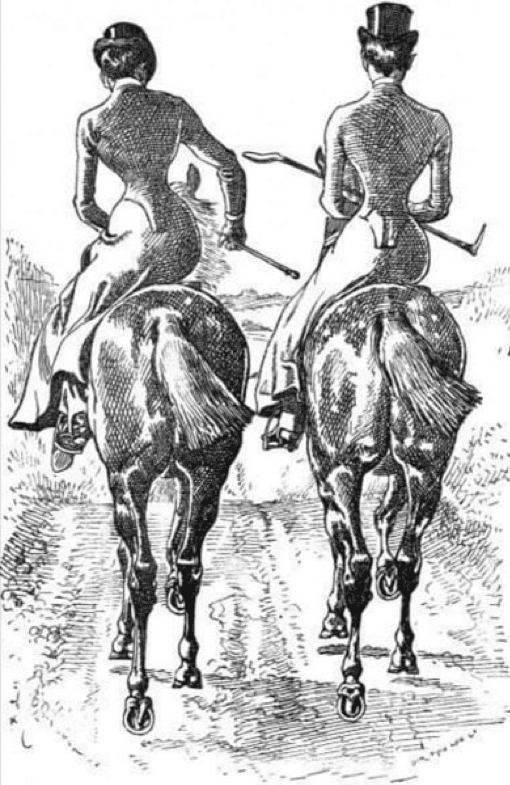
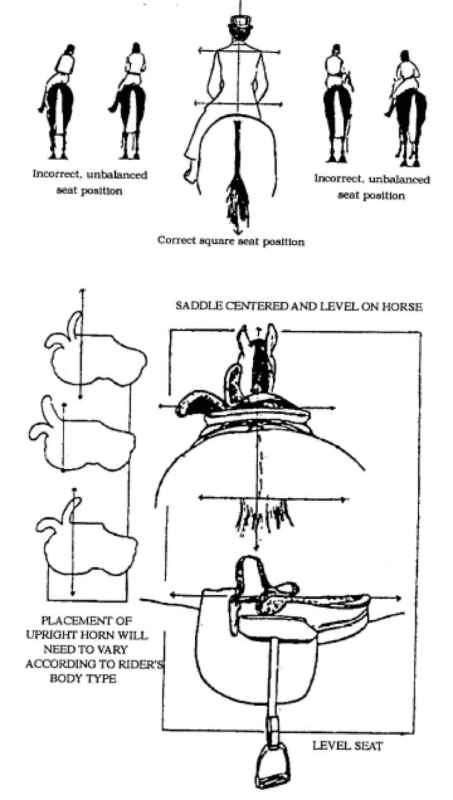
Illustrations from ladies’ riding textbooks showing correct and incorrect posture
As for the increased danger of a ladies’ saddle, compared to riding in a regular saddle. First of all, the question arises When did riding and working with a horse cease to be, in principle, dangerous to life and health?
It is very difficult to fall out of the lady’s saddle – the horns interfere. The “classic” version of falling out of it is to the right back. Therefore, several solutions have been developed over several decades for the greater safety of beautiful riders.
The first was the safety stirrup, which made its way from a shoe that prevented the foot from slipping into the stirrup, to a complex mechanism that unfastened in the event of a fall of the rider. Between 1767 and 1876, about 20 modifications of unbuttoned stirrups were patented. Some English experts on the sidesaddle argue that it is to the riders in the sidesaddle that today’s athletes owe the appearance of a safe stirrup.

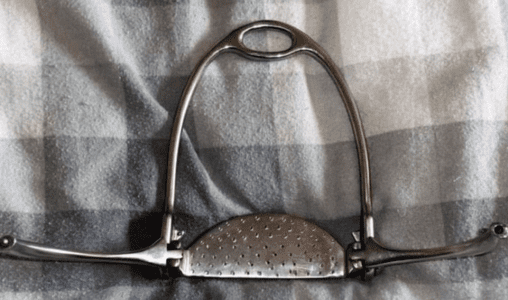


The safe stirrup was replaced by a more advanced system at the end of the XNUMXth century – safe Schneller. There were much fewer patented systems compared to the safety stirrup, the most popular and widely used to this day are the systems of three English saddle shops: Champion & Wilton, Owen & Co and Mayhew. The general principle of operation of the safety shneller is to quilt the trouser together with the stirrup in the event of a rider falling.

Safe Schneller Owen&Co

Mayhew Safety Schneller
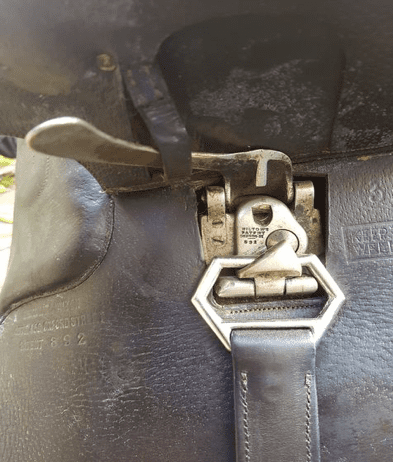
Safety Schneller Champion&Wilton
A clear example of how difficult it is to fall out of the ladies’ saddle.
Abroad, however, ladies’ riding is currently experiencing its second rebirth. The 1880s-1930s were the heyday of ladies’ riding, which was considered the only proper way for women to ride – a custom that was quickly abandoned during World War II.
According to Janet Arnold (British clothing historian, costume designer, teacher, restorer and author), in the second half of the XNUMXth century, this practice fell out of fashion and was considered an occupation of a minority, an archaic, even oppressive symbol of a bygone age: “Lady saddles were used at the time for theatrical performances and historical reenactments, and were also the prerogative of the women of the British royal family during state ceremonies.”
In 1959, the American writer and equestrian Lida Fleitmann Bloodgood lamented that side-saddle riding had become obsolete and “the same anachronism as the cabriolet, the crinoline and the minuet.”
The Side Saddle Association of Great Britain later revived the elegance of this traditional style of riding. Originally called the Women’s Side Saddle Association, the organization was founded by Valerie Francis and Janet McDonald in 1974. After forty years of oblivion, the ladies’ saddle has experienced a new heyday.
Around the world, many associations and organizations of ladies’ riding are currently registered and successfully operating, many of which were registered in the first wave of revival – the seventies of the XX century:
- Amazones de France (1973) France;
- The International Side Saddle Organization (1974) США;
- The Nederlandse Vereniging het Dameszade (1979) Нидерланды;
- NEA Sidesaddle Association (1979) США;
- Sidesaddle Association of South Australia (1980);
- The Side Saddle Association of Ireland (1981) Ireland;
- Riding Side Saddle (1997);
- American Sidesaddle Association (2008) США;
- Ontario Sidesaddle Association (2010) Canada.
In addition, there are associations in Austria (Reiten im Damensattel in Österreich), Spain (Asociación Española de Monta a la Amazona), New Zealand (New Zealand Side Saddle Association Inc.), Sweden (Damensattel-Verein Schweiz) and many other countries.
As part of foreign horse shows, including such large ones as HOYS in the UK, SICAB in Spain and Equitana in the USA, Germany and Australia, separate classes are held in various equestrian disciplines for side saddle riders.
One of the most prestigious events in the world of ladies’ riding, the National Side Saddle Show (Great Britain), which celebrated its fortieth anniversary last year, annually gathers about 200 participants competing in more than 75 classes.
If things were really as bad as negative netizens claim, would the side saddle still be so popular and would more riders use outdated, uncomfortable and dangerous sports equipment?
* Quotations are given from the textbook on women’s riding “Side Saddle”, published for the first time in 1938, subsequently revised and reprinted several times, by the author Doreen Archer Houblon, a famous English rider, ladies’ riding coach. She trained Queen Elizabeth II and for 19 years prepared horses for the Trooping the Color parade held annually to celebrate the Queen’s birthday. Inventor of a modification of the upper horn of the side saddle that improves the fit when riding fast over rough terrain and jumping.
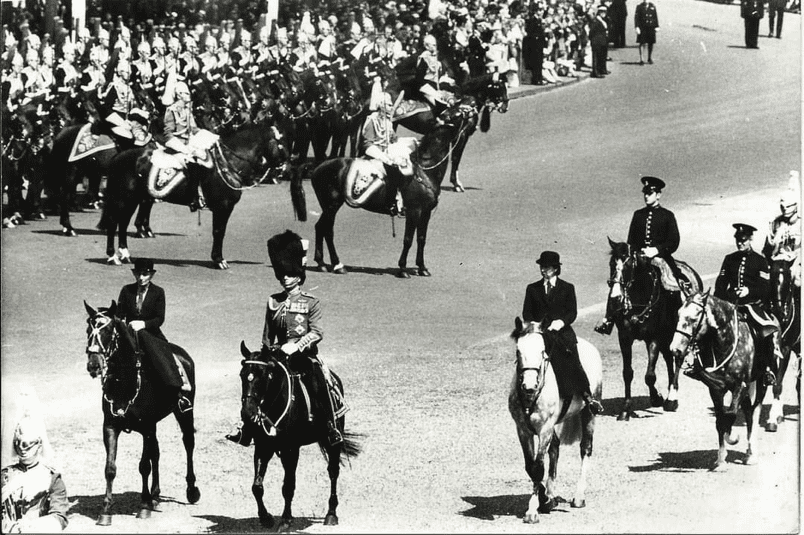
Doreen Archer Houblon pictured left on a spare horse for Queen Elizabeth II





